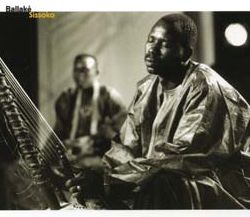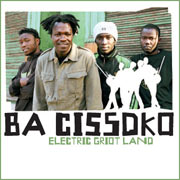
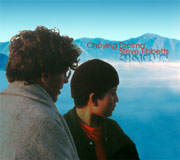
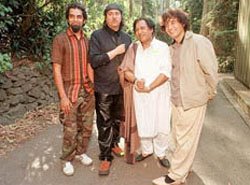

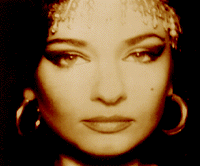
OK Here's what's playing tonight on the show.
Natacha Atlas- CD Gedida
Amazon.com The swirl of Egyptian strings, hip-hop beats, love, and politics can make strange bedfellows, but once again Natasha Atlas, chanteuse and belly dancer, makes sense of it all. Singing in several languages (including French on the opener "Mon Amie la Rose") she delivers 11 exotic worldbeat tracks full of exuberance, reflection, and yearning that are at once compassionate and militant, her Arabic roots sharing center stage with her club experiences with the likes of Transglobal Underground. Funky beats, kanoun, oud, string sections, and percussion jostle for attention in the background as Atlas's serpentine vocals entwine the listener in tales of passion, injustice, and the mysteries of life. Recorded both in London and Cairo, Gedida is a truly cosmopolitan melting pot for the '90s, ranging from hip dance-floor grooves to traditional Egyptian orchestral arrangements, and Atlas, equally at home in both, is fast proving herself one of the most intriguing and original artists blending international cultures into a common musical language. --Derek Rath
Rachid Taha- CD Tekitoi- Tekitoi / H'Asbu Hum
French-Algerian singer Rachid Taha's view of world events is not one that's shared by many people. He was quoted recently by BBC's 'The World' as saying, "When I hear George Bush, and when I hear Osama bin Laden, I hear two bedouin nomads. The only difference he says, is that one of them is from the desert of Texas and drives an SUV, and the other is from the desert of Saudi Arabia and rides a dromedary." Taha says Bush and bin Laden come from similar well-heeled backgrounds. And both, he says, use a similar fundamentalist rhetoric
Rachid Taha / Cheb Khaled / Faudel- CD 123 Soleils- Khalliouni Khalliounni
Amazon.com The swirl of Egyptian strings, hip-hop beats, love, and politics can make strange bedfellows, but once again Natasha Atlas, chanteuse and belly dancer, makes sense of it all. Singing in several languages (including French on the opener "Mon Amie la Rose") she delivers 11 exotic worldbeat tracks full of exuberance, reflection, and yearning that are at once compassionate and militant, her Arabic roots sharing center stage with her club experiences with the likes of Transglobal Underground. Funky beats, kanoun, oud, string sections, and percussion jostle for attention in the background as Atlas's serpentine vocals entwine the listener in tales of passion, injustice, and the mysteries of life. Recorded both in London and Cairo, Gedida is a truly cosmopolitan melting pot for the '90s, ranging from hip dance-floor grooves to traditional Egyptian orchestral arrangements, and Atlas, equally at home in both, is fast proving herself one of the most intriguing and original artists blending international cultures into a common musical language. --Derek Rath
Garbarek / Brahem / Hussain- CD Madar- Jaw
Tabla Beat Science- CD Live in San Francisco at Stern Grove - Mengedegna
Featuring master percussionist Zakir Hussain, with Ustad Sultan Khan (sarangi and vocals) Ejigayehu "Gigi" Shibabaw (vocals) Bill Laswell (bass) Karsh Kale (drums, tabla) DJ Disk (turntables) Midival Punditz (electronics) Fabian Alsultany (synthesizers) Unpredictability is often the soul of a live performance, especially when it arises from an entirely new fusion of genres and cultures. So it happened that on August 12, 2001, in this same spirit of the unexpected, a group of high-caliber musicians under the name Tabla Beat Science convened outdoors among the towering eucalyptus trees of Stern Grove in San Francisco. Melding traditional Indian rhythms, African vocal styles, modern electronics, low-end dub bass and DJ breakbeats into a two-hour sonic experience, the music of Tabla Beat Science left an indelible mark on the thousands of people who were there to witness it. Live in San Francisco at Stern Grove (Axiom/Palm) recaptures the electricity of that day, and continues in what has become a tradition of monumental live recordings that bear the ineffable stamp of a Bay Area event, from Carlos Santana's Live at the Fillmore to Miles Davis' Black Beauty and beyond. ?I was definitely trying to emulate that sound, especially Miles' live sound from the early '70s, and to make it even larger," says bassist/producer Bill Laswell about the mixing process. "What's crucial is having that energy in the original performance, where you know everyone is feeling it on stage. If you don't have that, no matter how many times you mix it or how you manipulate the tape later on, it will never sound right. We were all pretty relaxed - we actually had a day to rehearse a few ideas, which is a rarity - and we had the right energy and the right atmosphere. We didn't edit or overdub anything in the studio; everything you hear is as it was played." Tabla Beat Science began as a collaborative studio project between Indian-born tabla maestro Zakir Hussain and Bill Laswell, and has since grown to embrace a loose configuration of artists and a sub-culture of its own. The Tala Matrix CD, released on Axiom/Palm in September 2000, features "tablatronics" pioneer Talvin Singh (whose solo debut OK had won the UK's prestigious Mercury Prize the previous year), as well as impeccably recorded performances from vocalist and sarangi master Sultan Khan, Bombay percussionist and jazz veteran Trilok Gurtu, and Brooklyn-based drummer and producer Karsh Kale. The record drew praise from press and audiences alike, prompting The New York Times to rave, ì´¨e music is too aggressive to be ambient and too abstract for the dance floor; ití©¯ a genuine fusion that pours energy into the air, pauses to meditate and then rushes forward again. Live in San Francisco at Stern Grove reunites four of the core contributors to Tala Matrix and develops several pieces from that record into fully expanded live dub excursions, taking a cue from the Jamaican "dub style" that has had such a profound influence on rhythm sections today. The frenetic cut-time beats of drum-n-bass represent the modern offshoot of that style, and this is where the artistry of Zakir Hussain's tabla comes into full effect. From the long meditative duet with Sultan Khan called "Taaruf" that opens the set, he segues with a flurry into "Sacred Channel," an aggressive re-working of the Tala Matrix track "Secret Channel". Suddenly, hypnotic waves of pulsating low-end dub - connected by a seamless exchange of hyper-accelerated chops between Hussain, Laswell and Karsh Kale - take the sound of the tabla from the ancient past into an electric future. The worlds of East Africa and the Asian subcontinent merge with surprising harmony in "NafekeÒ¬" the signature song of Ejigayehu "Gigi" Shibabaw. Singing in her native Amharic tongue from Ethiopia, Gigi renders the vocal melody with jubilation, and is joined on the microphone by an inspired Sultan Khan, his voice as hauntingly beautiful as that of his multi-stringed sarangi. Khan Sahib (as he is known among friends and admirers in Mumbai, India) later takes the vocal spotlight for himself in "Magnetic Dub," a version of another Tala Matrix track that brings a lilting sarangi line together with undulating bass to close the first set on a euphoric high. The second set offers a taste of breakbeat culture as DJ Disk steps out on "Tala Matrix". Known in the Bay Area for his collaborations with Q-Bert and Mixmaster Mike, and as a founding member of the now-legendary Invisibl Skratch Picklz turntablist crew, Disk cuts his way into a raga of his own, with Hussain following his every move on various percussive instruments and Laswell and Kale coming in with a pulsating backbeat. The progressive electronic thread is then taken up by the Delhi-based production duo Midival Punditz, whose Bollywood-sounding drum loops and string orchestrations weave their way through "Trajic". By the time Gigi takes the stage again on "Mengedegna," everyone - musicians and audience alike - seems to sense that something completely new is being created here. And when the bhangra-tinged "Devotional Dub" draws the audience into its own rhythmic accompaniment, the music floating on a chorus of handclaps, it's clear that whatever may have been unplanned about this performance has somehow solidified into the feeling of freedom and soul that a truly live event brings.
Talvin Singh- CD Ha- Silver Flowers
Bedouin Ascent- V/A Arabian Travels Vol 2- Ganga Dev
Jalillah's Raks Sharki 6-CD In A Beirut Mood- Rakset Banat Baladi (Dance of The Country Girls) (www.calabashmusic.com)
In A Beirut Mood
Raks Sharki literally means Oriental Dance, what Americans know as "belly dance", a misnomer carried on down from colonial days in the Middle East. Since the 1960s, "belly dance" has become tremendously popular in the U.S. with schools, workshops, festivals, new "tribal" offshoots, and performance gatherings. This phenomenon has been well covered by social scholars who also examine, for instance, the search for cultural identity among white salsa dancers and those of American bands playing Balkan music. While still in high school Jalilah, a woman of German and Mexican descent raised in California, was attracted to the sound of the mizmar (the double-reed instrument). That launched a lifelong career devoted to the study and practice of Raks Sharki involving research and much foreign travel, performance, and teaching others what she has learned. During this process, Jalilah gathered a band of musicians around her to perform while she danced. Is she popular? While it might be considered somewhat unusual for a dancer to put out a record, this is her second collaboration with Lebanese composer Ihsan Al-Mounzer and the sixth full-length album of the music created for her dance productions.
First off, this is the music of Raks Sharki, not the music of the form commercialized as nightclub "belly dance". The long running opening piece is traditional to the dance performance, an introduction of the dancer to the audience. "Tales of the Sahara" caps out at 11 minutes, and exhibits many of the motifs expected of most opening dance numbers, which means heavy on the strings, expansive instrumentation which brings in elements of popular tunes, and unusually energetic to entice the interest of the crowd. These long presentations are also designed to show off a little bit of what the dancer can do, and so the music is broken into distinct movements. A third of the way through, there's a particularly charming and mesmerizing interlude that mimics the sway of camels walking and the tinkle of their bells. Then the mizmar drops in with a hypnotic riff (the "snake charmer" sound popularized in film) and you'll keep an eye on the lid of that basket in the corner in spite of yourself. Soon, the rhythm excites into a hip-shaking shimmying mode. These long musical introductions also acquaint the musicians to the audience, so each instrument is allowed a prolonged phrase for accent -- which means an oud break as well as a tabla solo. The dramatic "Tales of the Sahara" was actually composed for a theatre play (starring the late Lebanese dancer Dani Boustros), but the structure naturally lends itself to being incorporated into dance performance.
What's so endearing about In a Beirut Mood is that the music selection, rather than the nightclubby coin-jingling or the glitz and flash fare popularized throughout the U.S., honors the traditional forms that are still popular everywhere in Lebanon and Egypt. The drums and flutes (tabla, mizmar, and ney) are each accorded its own track, again to introduce the musicians and sound of their instruments. "Beirut Rhythms", is devoted to showing the percussive skills of drummer Bassem Yazbek. Just hearing this long rhythmic groove, one which likely took years of time-consuming and devoted practice to carry off effectively, brings a completely different image of Beirut to mind other than the bullet riddled buildings once so popular on American news broadcasts. The high-pitched mizmar sounds a bit lonely on "Mizmar Jabali", as if it is calling for other instruments to come play with it (which they soon do -- who can ignore the mizmar for long?). Then the slow slap of tabla before a long soulful breathy excursion into the sounds of the nay on "Ali's Nay". Traditionally, this wood flute is associated with the fluid snake-like movements in dance.
When everybody gets together on the next track, it's party time. "Lebanese Bouquet", which contains the traditional folklore that might be found at a Lebanese wedding, is announced by the wail of the mizmar, a sound that always gets attention. Violins, drums, the sparkling rattle of finger cymbals, and voices sliding together in song soon unite before an oud adds accent to the vocal chorus. The song slips through four distinct movements, some so irresistibly happy and appealing that you'll imagine the dancers as they spin. All the melodies were re-arranged by Ihsan Al-Mounzer so they can be danced to Raks Sharki style, and his are very complex arrangements.
"Rakset Banat Baladi" ("Dance of the Country Girls") is described as a "conversation between the accordion and tabla". The accordion hits minor and modal notes and ascends in stuttered climb in an undeniably Arabic sounding progression. This piece starts out slow and stately for the Egyptian baladi dance, then after six minutes the rhythm really picks up pace for the concluding two minutes. The opportunity to dance in another style is soon offered with "Kanoun Mood", played entirely by the kanoun -- a metal stringed instrument that sometimes sounds like a zither, other times like a dulcimer. The sustain and echo of the instrument and the long sounding brushes of the strings seems the perfect accompaniment for dancing in the kanoun style, which has many trembling and quivering movements.
Everybody gets down for "Al-Houriyah" ("The Fairy"), a 14-minute extravaganza that tells about those beautiful heavenly beings that live in Paradise. There is fascinating use of accordion here, as all the other pieces that feature Mohammed Haidar's playing on this record. His work, though often in ensemble setting, is so stand out it can't be ignored. Which makes me realize that I've never before been so conscious of accordion associated with the music of Raks Sharki.
Aside from the call for prayer from minarets and the sound of the oud growing more popular in the '60s, the most distinctly and recognizably "Arab sounding" music to the American ear is that made for Raks Sharki. The music on In a Beirut Mood is quite fantastic, providing a good cross section of styles and a learning experience that eases recognition of individual idiom. More than that, it's a lot of fun. If there's only one record devoted to Raks Sharki music in your collection, you'll be happy with this, but it will always make you want to see Jalilah dance. — 9 March 2004
Kim Sanders with Peter Kennard- CD Trance'n'Dancin-Soporific Taksim / Bebek
Zulya- CD Aloukie-
Artist of the Year 2001 (Australian World Music Awards) World Music Artist of the Year 2002 (Australian LIVE Music Awards) Album of the year 2000 for Aloukie (Australian World Music Awards) World Music Album of the Year 2003 nomination for elusive (Australian Record Industry Awards, ARIA) Multi award-winning ZULYA KAMALOVA is the leading proponent of Tatar music in Australia as well as one of the most versatile and accomplished vocalists on the world music scene today. A native of Volga-Kama region of Central Russia, ZULYA began performing Russian and Tatar songs at the age of 9. Later she studied music and languages at university level. Inspired by the diversity of cultures, she made a dramatic decision to settle in Australia in 1991 and began to not only share her traditional music with Australians, but to explore the musical and linguistic riches of the multitude of cultures living side by side in Australia. As a result, ZULYA has developed a totally original approach as an affirmation of her unique identity - an affirmation that takes her Tatar and Russian background to totally new places and in completely new ways. After a recent tour of Europe and a prolonged stay in Moscow, ZULYA is at the edge of an exciting new stage in her already illustrious career. ZULYA's first release in Australia, Journey of Voice (1997), a unique collection that ranges from sweet Russian lullabies to French cabaret to Brazilian Bossa Nova to South African township jazz and more, received accolades for its versatility, passion and the "achingly beautiful" tone of her voice. In the following years, Australian audiences have been able to witness the continuing rise of this unique musical treasure. ZULYA's later albums, Aloukie (1999) and elusive (2002) have recently been released in Europe and have been awarded and nominated for various awards - the World Music Album of the Year 2000 at the Australian World Music Awards (Aloukie) and ARIA 2003 (elusive). These albums feature traditional and original songs in her distinctive Tatar style but with unusual instrumentation (kora, oud, bouzouki, litungu, jaw harp, kalimba, tuba, flugelhorn, saxillo, tabla, ghatam, violin, accordion and others) presenting the traditional music from a new perspective. Several tracks from these albums have been included in various compilations such as Putumayo's "Music from the Tea Lands" and "Dreamland" along with many others. ZULYA's work has been repeatedly featured on national radio and television to high acclaim, and she was also awarded "Female Artist of the Year" at the World Music Awards (2001) and Best World Music Artist by Australian Live Music Awards (2002). ZULYA has been described as "a remarkable singer, who is not merely versatile..." by Doug Spencer of ABC Radio National.
She has worked with Bob Brozman, Nikola Parov, Slava Grigoryan, 'Sirocco', Llew Kiek and Epizo Bangoura among others. ZULYA continues to dazzle audiences with her multi-cultural proficiency and passion for music and song and during the last few years has performed at many major venues and festivals in Europe, Russia, Tatarstan and of course in Australia including The Moods (Zurich, Switzerland), Kulturbrauerai (Berlin, Germany), Savoy Teatteri (Helsinki, Finland), Szene Wien (Vienna, Austria), Cafe de Overkant (Netherlands), Kulturfabrik (Luxemburg), Red Square (Moscow, Russia), Piramida (Kazan, Tatarstan), Living Water festival (Altai Mountains, Russia), Red Club (St.Petersburg, Russia) and WOMADELAIDE (SA), Sydney Opera House - Festival of Asian Music and Dance (NSW), The Basement (NSW), The Boite Winter Festival (Vic), National Folk Festival (ACT), "10 Days on the Island" Arts festival (Tas), Woodford Folk Festival (Qld), Brunswick Music Festival (Vic), Brisbane Biennial Festival of Music (Qld), Apollo Bay Music Festival (Vic), Kulcha (WA), Musician in Residence Program, Aboriginal communities (N.T) etc. With her outstanding new band, The Children of the Underground (Anthony Schulz - accordion, Lucas Michailidis - electric guitar, Andrew Tanner - double bass, Justin Marshall - drums), ZULYA has just recorded her long-awaited Russian album, The Waltz of Emptiness (and Other Songs on Russian Themes).
Steve Tibbetts & Choying rolma- CD Selwa- Palden Rangjung / Mandala Offering
In 1997, Choying Drolma and Steve Tibbetts (a guitarist from Minnesota) created an international stir with a remarkable album of Tibetan Buddhist chants paired with atmospheric soundscapes of guitar and percussion. The guitarist was Steve Tibbetts, and while he'd built up a bit of a reputation through his critically-acclaimed albums for ECM Records, he created something profound, and profoundly different, in his collaboration with the Tibetan Buddhist nun Choying Drolma. Rather than a slick piece of Western dance music with appropriated Eastern melodies, this was a carefully produced, deeply felt sonic environment built around and in response to an ancient practice of visualization and meditation. The Tibbetts/Drolma album was unlike anything else that was happening at the time, and it's taken seven years for anyone to follow in their footsteps. Finally, in their Six Degrees Records debut, Steve Tibbetts and Choying Drolma have released a new recording, called Selwa, which expands on the work they began in that first groundbreaking album. Choying Drolma practices a form of Vajrayana Buddhism that involves cutting through the various physical and spiritual obstacles to enlightenment (the title means "cutting"), and that practice can take the form of a fairly vigorous meditation, often undertaken in provocative settings like graveyards. Tibbetts approaches this sort of source material with an uncommon humility and a healthy amount of respect. On Selwa, Tibbetts establishes his panorama of sound early on, with the moody, nocturnal instrumentation of "Palden Rangjung." Its flowing ambient acoustic guitar, drones, effects, and slow, almost tribal hand drumming echo the dark vision of Drolma's supplication: Powerful blood drinker, glorious vitality In the land of Yama, you are Ekajati Fire eater, blood wearer, wearing the naga emblems Kali, the Blood Dripper, I praise you. On a somewhat lighter note, Choying Drolma's singing on the track "Vakritunda" reflects both the sounds of devotional Hindu bhajans and contemporary Hindi pop music. "Vakritunda" is a piece with slightly more Western-sounding percussion and an example of the tasty, guerrilla guitar solos that sneak into much of Steve Tibbetts' work. Perhaps the centerpiece of the album is "Song of Realization," an epic blend of multiple voices, hand drums, acoustic and electric guitars, and other less easily identified sounds. It is at once a transcendent and grounded work - again, because it follows the text of the aspiration prayer: I do not recognize this earth as earth It is an assembly hall adorned by flowers. I do not recognize me to be me I am the supreme victor, the wish-fulfilling jewel. The new album was built around recordings made by Tibbetts and his longtime percussionist Marc Anderson in Boudhanath, a Tibetan enclave in the Himalayan country of Nepal. There, not far from a school for nuns that Choying Drolma has founded, they recorded her chants, often feeding a drone into her headphones to set the pitch before letting the tape roll. "It seemed like she was singing with four lungs," Tibbetts recalls. "Some of her takes left Marc and I somewhat stunned. She'd finish the song. I'd quickly save the recording file on the laptop. Choying would say "Tik chha?" meaning, "it's okay?" and Marc and I would slowly nod." Back in Minnesota, Tibbetts and Anderson wove together tapestries of acoustic and electric guitars, shifting drones, and subtle hand percussion. They enlisted the support of Lee Townsend, who has produced most of Bill Frisell's recordings, and created an organic blend of ancient and modern, Eastern and Western. Guitar aficionados have been following Steve Tibbetts' since 1977 as he has steadily gone about making himself one of the more inventive musicians on the American music scene. To a wider audience, however, Tibbetts remains a mystery. His albums reflect his own interest in everything from 1970s progressive rock (King Crimson, Eno, etc.) to ambient electronica, to world music. But the two collaborations with Choying Drolma occupy a special place in Tibbetts' music. Choying Drolma is a fascinating character herself. She told an interviewer "Even before I was a nun I always had this thought, this question, wondering why, if boys can do something, why can't girls? That kind of attitude continued with me even in the nunnery. I would see lots of male teachers come and teach. All males. Why is it only monks that go on to become teachers, to get these chances? The Tibetan word for "woman" translates as "low birth." I hated that." She decided she wanted to change the traditional lot of women in Tibetan society, and given her notoriety since 1997, Choying has found the opportunity to do just that. "That's what I want to do with the school I've started, the Arya Tara school. I want nuns to learn many things and know why they are doing what they are doing, what the benefit is in it. Not just in practicing Tibetan Buddhism, but in learning math, English, learning basic medicine. If they're doing something, they must know why they are doing it." Perhaps the most impressive thing about Selwa is that the musicians know "why they are doing it." On the surface, it seems a bizarre collaboration: Why would a pair of American musicians want to spend the time and effort to learn these chants and create a sonic environment that brings them to the West? Again, the answer lies in the text of one of the aspiration prayers. The concluding lines of "Song of Realization" read: If you understand this song, it will be molasses for your ears. If you cannot understand it, you have no connection with this song. Selwa is about understanding - not a literal understanding of the Tibetan meditations themselves, but an understanding of the practice of undermining the machinery of conceptualization; creating a space of non-thought, clarity, compassion, and bliss. Selwa offers an unexpected connection to a tradition that's over a thousand years old.
Joseph Tawadros- CD Storyteller
